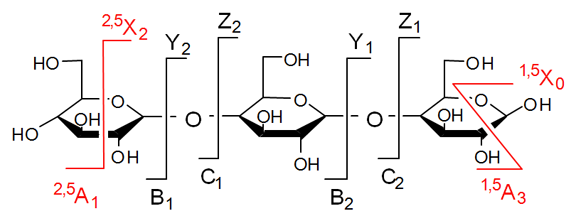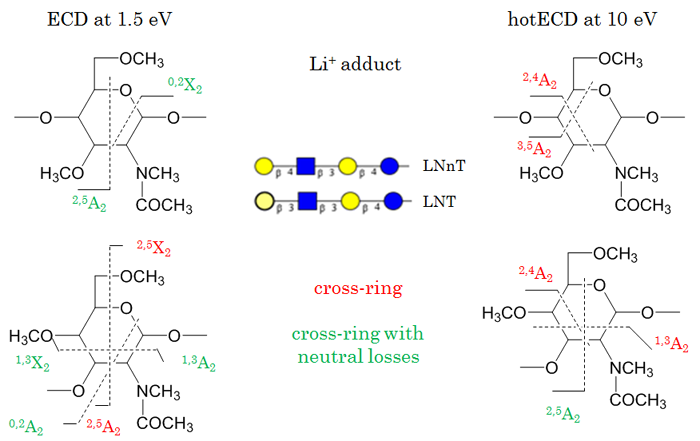Electron Activated Dissociation (ExD) of Glycans
Glycans are complex biopolymers that play a diverse role in all living systems. A glycan consists of multiple monosaccharide residues linked together via glycosidic bonds. Complete structural characterization of glycans is a challenging task, requiring determination of not only its constituent residues and topology (a two-dimensional sequence), but also its linkage and stereo configurations. Conventional “slow-heating” fragmentation methods such as collisionally activated dissociation (CAD) tend to break the weakest bond within a molecule, in this case, the glycosidic bond. Although glycosidic cleavages are informative for determination of the composition and, when combining with permethylation and multi-stage MSn, the topology of the glycan, they do not provide linkage information. Linkage configuration is usually deduced from cross-ring fragments, which are often lacking in CAD spectra. The following figure illustrates the general nomenclature scheme for glycan fragments.

Electron activated dissociation (ExD) is a general term that describes a number of fragmentation techniques that take advantage of ion-electron or ion-ion reaction. Electron capture dissociaiton (ECD) is the first “popular” ExD method that made its way to biomolecule structural analysis. ECD is usually initiated by the electron capture of a multiply charged analyte cation, generating an odd-electron radical cation which can undergo further radical-induced reactions to produce a wide variety of fragment ions. ECD of metal-adducted glycans can generate abundant cross-ring fragments, making it a powerful tool for detailed glycan structural characterization. Other ExD methods, such as electronic excitation dissociation (EED), electron transfer dissociation (ETD) and electron detachment dissociation (EDD), have also been applied to glycan analysis. Each of these methods has its own unique character that makes it useful in certain applications. For example, EED is amenable to analysis of singly-charged analytes, as it does not involve charge reduction; ETD can be implemented in a broader range of MS instruments, as it is initiated by the electron transfer between oppositely charged ions and does not require electron confinement; and EDD is applicable to analysis of negatively-charged analytes.
An application of the ExD method to linkage isomer differentiation is shown below, which demonstrates the influence of the electron energy on the fragmentation behavior of metal-adducted oligosaccharides: whereas the linkage type between the non-reducing end Gal (Galactose) and GlcNAc (N-acetylglucosamine) residues could not be delineated by low-energy ECD (left), hotECD (right) produced sufficient cross-ring cleavages within the GlcNAc residue for unambiguous linkage determination of each isomer.

The objectives of this project are to investigate the effect of various experimental parameters and structural variables on the ExD behaviors of glycans, and to apply such knowledge to develop a rapid, sensitive and routine analytical method for glycan structural analysis. These ExD methods will also be applied to analyze biological samples of interest to our collaborators.
Relevant Publications:
- Pu, Y.; Ridgeway, M. E.; Glaskin, R. S.; Park, M. A.; Costello, C. E.; Lin, C., Separation and Identification of Isomeric Glycans by Selected Accumulation-Trapped Ion Mobility Spectrometry-Electron Activated Dissociation Tandem Mass Spectrometry, Anal. Chem. 2016, 88 (7), 3440-3443.
- Yu, X.; Jiang, Y.; Chen, Y.; Huang, Y.; Costello, C. E.; Lin, C., Detailed Glycan Structural Characterization by Electronic Excitation Dissociation, Anal. Chem. 2013, 85 (21), 10017-10021.
- Huang, Y.; Yu, X.; Mao, Y.; Costello, C. E.; Zaia, J.; Lin, C., De Novo Sequencing of Heparan Sulfate Oligosaccharides by Electron-Activated Dissociation, Anal. Chem. 2013, 85 (24), 11979-11986.
- Yu, X.; Huang, Y.; Lin, C.; Costello, C. E., Energy-Dependent Electron Activated Dissociation of Metal-Adducted Permethylated Oligosaccharides, Anal. Chem. 2012, 84 (12), 7487-7494.
- Zhao, C; Xie, B.; Costello, C. E.; O’Connor, P. B. Collisionally Activated Dissociation and Electron Capture Dissociation Provide Complementary Structural Information for Branched Permethylated Oligosaccharides, J. Am. Soc. Mass Spectrom. 2008, 1, 138-150. Link